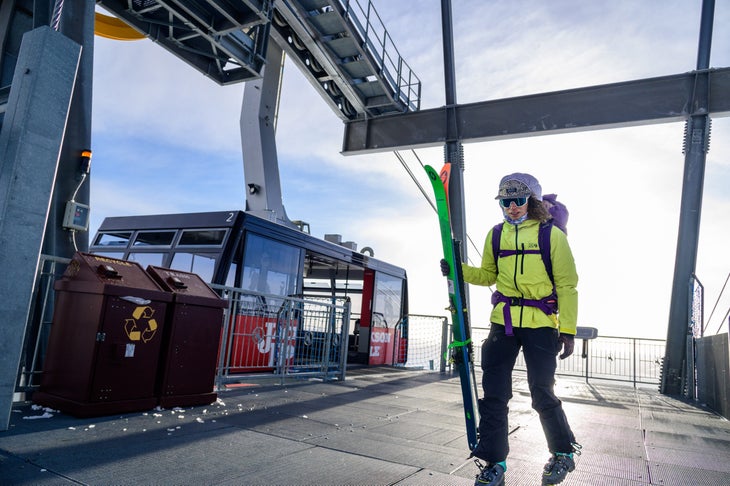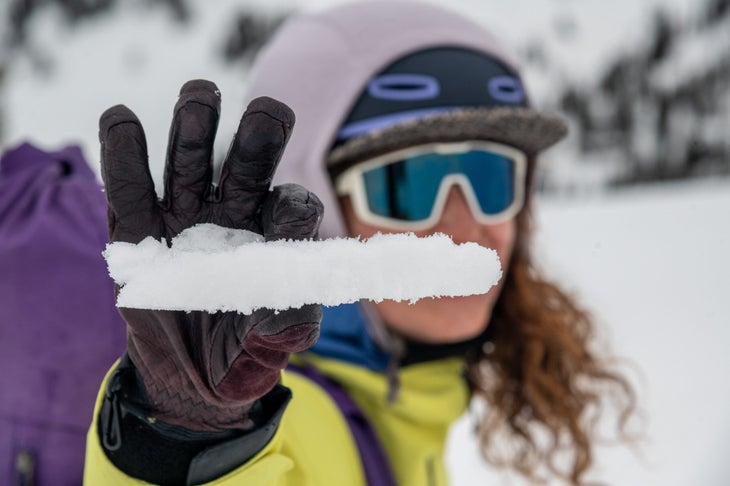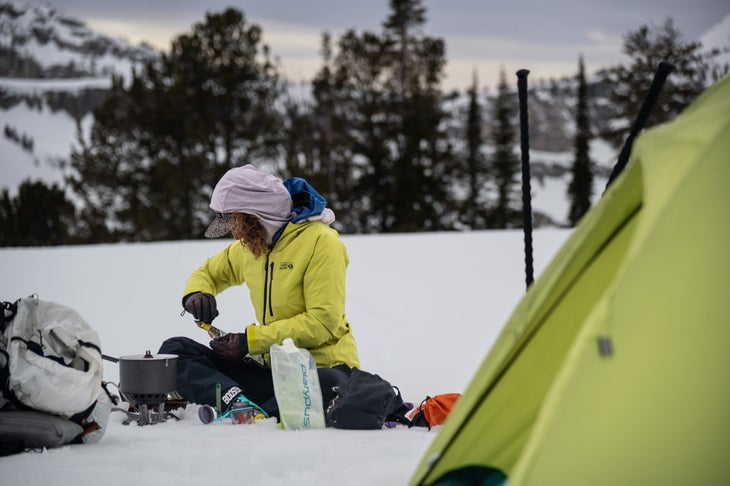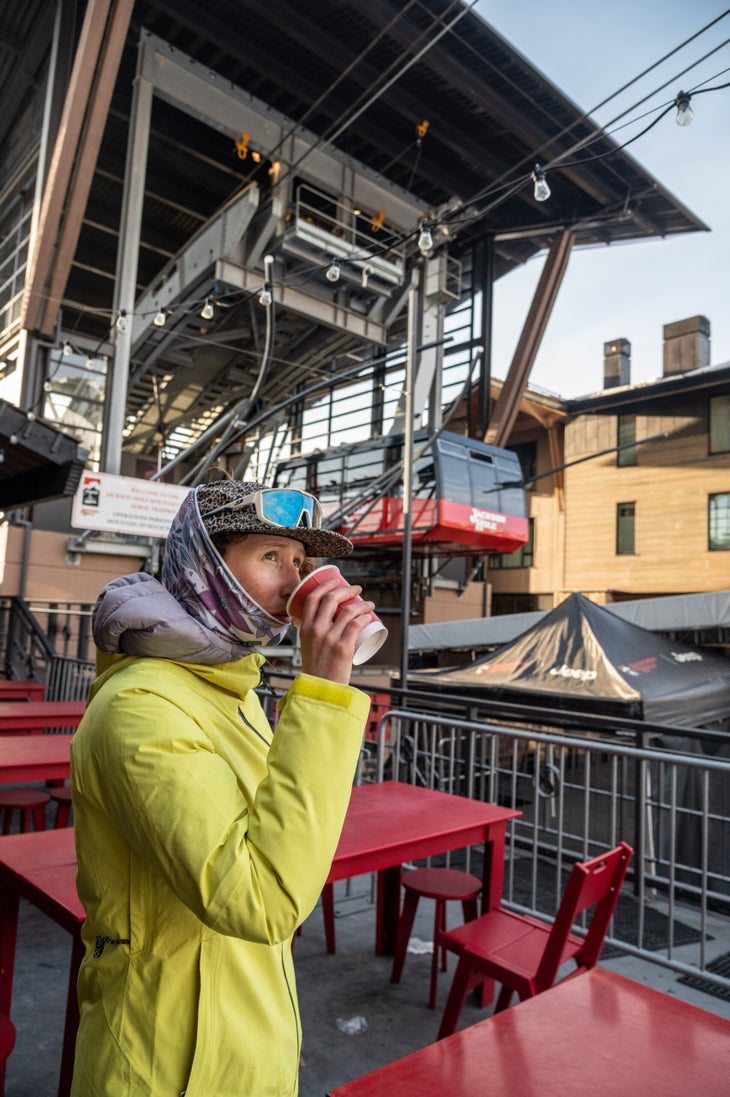Products You May Like
We’re five minutes into our journey and I’m already sweating. Vibram soles scratching on pavement, I frantically unzip my leg vents, shoulder my skis, and chase Max down the block as we try to catch the 7:30 a.m. bus to Teton Village. We collapse onto the bus just in time, bulging backpacks raising eyebrows from morning commuters.
Ski Touring This Spring? Start With Our Ultimate Guide to the Backcountry
We’re on our way to Grand Targhee Resort, but we’re doing it the hard way. Twenty-five miles of wilderness stretch between Jackson Hole Mountain Resort and Targhee, a remote corner of the range that rarely sees winter traffic. My ski partner, photographer Max Ritter, and I had long caught glimpses of the peaks, couloirs, and wide-open basins that snake along the backside of the Tetons, but the terrain between JHMR’s tram and Targhee’s Trap Bar remained a mystery.
We’d been plotting this Tram to Trap traverse since last season, mapping out a route that would include descents of some of the big peaks in the range—Mount Bannon, Housetop, and the Wedge, along with some of the mini-golf couloirs scattered along the Death Canyon Shelf—but a lingering persistent slab problem, wet slides, and new wildlife closures wiped our ski mountaineering objectives off the table. “Is it still worth making the trip?” I wondered as we pored over our topo maps, crossing off lines that we’d been drooling over while scoping our route from the Tram. But spring was roaring into the Tetons like a lion, melting our snowpack at record rates. So instead of scrapping the plan altogether, we figured we might as well do some exploring, sticking to mellower slopes and crossing the range in two days instead of three.

We hop off the bus at the base of the Tram and catch the first box, a welcome 4,000-foot bump to kick off our journey before we head out of bounds. It hasn’t snowed in over a week, and temps have been hovering around 40 degrees midday and barely freezing at night, so unsurprisingly, we’re almost entirely alone on our ride up.
Must Read: Gear You Need for Spring in the Backcountry
After a quick gear check at Corbet’s Cabin, we leave the safety and comfort of JHMR and head out of bounds towards Cody Peak, where we drop off the west side instead of heading higher up to some of the classic east-facing descents. One punchy turn off Cody and we start to get an idea of the type of adventure we’re in for. It had been windy and warm, but we’d hoped to at least be traveling on a mix of firm, supportable wind board, a bit of corn on south faces, and soft, shaded powder on north facing trees. Turns out, that was wishful thinking.
After muscling our way down 800 feet of agonizing wind crust, we gratefully put our skins back on to start our rolling journey through the belly of the Tetons, skinning over snow-covered alpine lakes and wide open plateaus, scoping peppery, walled-in couloirs that probably skied clean on higher snow years.
No matter how much I enjoy skinning, I’m a skier first and foremost; it’s always about the descent. This type of skiing—a long, exploratory traverse—was a new kind of adventure, but one that I found exhilarating in its own fashion. Weighed down with overnight gear, my legs felt heavy, but each time one of us wanted to plop down and take a break, we couldn’t help but keep plodding along, fueled by the desire to see what was around the next corner. Hidden corners of the Tetons spilled out in front of us, nudging us to keep going.

In the Tetons, where you’re never more than a few minutes from a well-traveled skintrack, it’s rare to feel alone. The top of Buck Mountain, the South, Middle, and Grand Teton, and the Grand poked out above the ridgeline, but the terrain in front of us felt like a blank slate. We relished in the excitement of route-finding, carefully weaving through glacial erratics and high creek beds, stopping only to point out a new mini-golf zone, or hidden line tucked behind a rock buttress.
Mile after mile, the breakable crust stretched on. Every aspect and every elevation held a crust that ranged from one centimeter to two inches, entirely unsupportable, threatening our knees as we timidly tried to traverse and hop turn into each basin. We jokingly started calling our route the “Tour de Breakable Crust,” and agreed that it was probably best our ski partners had bailed.
Outside Learn Course: Backcountry Basics They Didn’t Teach You in Avy 1
After 13 miles of walking, we conceded to exhaustion and set up camp in Alaska Basin, firing up the stove for a hot meal. Perched next to a snow-covered alpine lake, we discussed the snow surfaces we’d encountered (all terrifying), and decided to pivot tomorrow’s route to avoid the steeper descent from Table Mountain we’d been planning on to gain the ridge east of Targhee. We’d break camp before sunrise and ski seven miles down South Teton Canyon before climbing up the long but low-angle slopes on the south-facing shoulder of Targhee’s backcountry. We’d have to climb an extra thousand feet and endure an extra mile or two of gnarly creek bed skiing, but the danger of skiing breakable crust in the alpine pushed us towards our conservative option, even though we’d be skiing some low elevation mank that wasn’t going to freeze. I cozied up into my sleeping bag before the sun went down (the best part of winter camping), sleepy and satisfied as I drifted off in the shadow of the jagged peaks all around us.
In the morning a rosy glow illuminated the high mountains behind us as we stuffed our packs to the brim and cautiously started down Teton Canyon. We stared up at the craggy summit ridge of Battleship Mountain as we pieced together open patches of semi-breakable snow swinging from foliage as we danced around the steep walls of the creek bed. A messy creek crossing (which resulted in one lost glove) and three miles of pushing led us to a fork in the valley, where we’d start our final ascent up to Targhee. The snow was hot and mushy (down here at 7,000 feet the snowpack hadn’t frozen), so our low-angle climb, while not dangerous in terms of slide potential, felt like trying to skin up a pile of soggy mashed potatoes. We were wallowing up to our shins with each heavy step. I gritted my teeth and swore each time I punched through the crust-encased slop, reluctant steps fueled by the thought of the ice-cold beers waiting for us on the deck at the Trap Bar.

Our slow march finally gave way to firmer snow up top. As we crested the ridge Max spotted the resort boundary, the promise of groomed snow and cold Modelos getting closer with each step. We ripped skins on top of Mary’s Nipple, a hike-to knob that usually delivers soft turns on a Targhee pow day. Energized by the promise of a smooth groomed run at the base of the bowl, we faced one more 700-foot descent of crunchy mank before we could truly relax. I couldn’t help but laugh as we picked our way down the bowl, tottering under the weight of our packs as we crawled towards the cat track.
As soon as our skis hit smooth, flat ground, a wave of relief washed over me. Relishing in the soft, creamy turns ahead, I turned to high-five Max, and three skiers in pirate costumes zoomed down the groomer past us, signaling our return to civilization. We had unknowingly stumbled upon Targhee’s Gaper Day and glancing around, our fast and light “outfits” (85mm skis, Max’s climbing helmet, overstuffed 50-liter packs, and slim-fitting softshells) made us look like the real gapers.
Exhausted and satisfied, we cruised down to the sundeck to our totally arbitrary finish line. A cold beer and plate of street tacos never tasted so good.
Trip Planning: How to Ski the Tram to Trap
The Tram to Trap takes some mildly complicated logistics to pull off, but it’s well worth the adventure. Like any outing in the backcountry, be sure you have the proper gear and knowledge before heading out.

Shuttle
Since you’ll end at Grand Targhee Resort (on the west side of Teton Pass), you’ll need to coordinate a pickup or shuttle a car to the other side beforehand. Parking at Targhee overnight costs $28 per vehicle per night, so we opted to shuttle a car to the Teton Canyon trailhead, 6.5 miles down the road from Targhee. Since it was a busy Saturday, we easily thumbed a ride down to the trailhead at the end. Having a car at the bottom of Teton Canyon also gives you an easy bail if conditions don’t line up for the final climb to Targhee.
Lift Tickets
You’ll need a lift ticket or season pass to Jackson Hole Mountain Resort to get you up the Tram. JHMR does not allow uphill access at any time, plus why not set yourself up for success with a 4,000-foot bump to the top?
Route
Our route was roughly 26 miles and 7,200 feet of elevation gain, more if you climb some nearby peaks along the way. From the Tram, we skied off the west side of Cody to meet up with the Teton Crest Trail. Following the Teton Crest Trail along the Death Canyon shelf, we camped in Alaska Basin, then skied into Teton Canyon the next morning. To finish, we climbed the south side of the Targhee backcountry, entering the resort via the boundary line at Mary’s Nipple.
Guide
Don’t want to go it alone? Contact Teton Backcountry Guides for options in the area.
